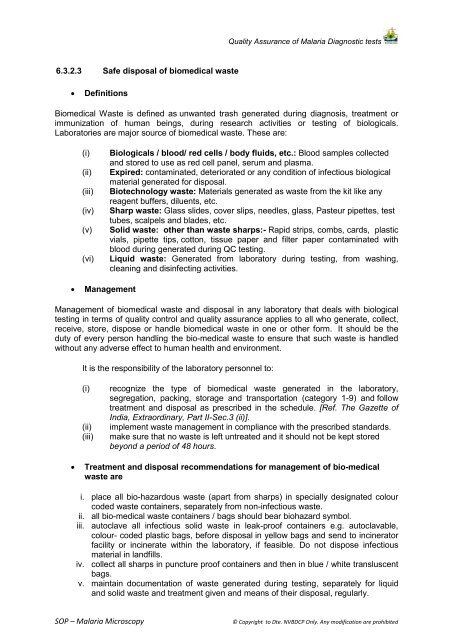SOP â Malaria Microscopy - NVBDCP
SOP â Malaria Microscopy - NVBDCP
SOP â Malaria Microscopy - NVBDCP
Create successful ePaper yourself
Turn your PDF publications into a flip-book with our unique Google optimized e-Paper software.
Quality Assurance of <strong>Malaria</strong> Diagnostic tests6.3.2.3 Safe disposal of biomedical waste• DefinitionsBiomedical Waste is defined as unwanted trash generated during diagnosis, treatment orimmunization of human beings, during research activities or testing of biologicals.Laboratories are major source of biomedical waste. These are:(i)(ii)(iii)(iv)(v)(vi)Biologicals / blood/ red cells / body fluids, etc.: Blood samples collectedand stored to use as red cell panel, serum and plasma.Expired: contaminated, deteriorated or any condition of infectious biologicalmaterial generated for disposal.Biotechnology waste: Materials generated as waste from the kit like anyreagent buffers, diluents, etc.Sharp waste: Glass slides, cover slips, needles, glass, Pasteur pipettes, testtubes, scalpels and blades, etc.Solid waste: other than waste sharps:- Rapid strips, combs, cards, plasticvials, pipette tips, cotton, tissue paper and filter paper contaminated withblood during generated during QC testing.Liquid waste: Generated from laboratory during testing, from washing,cleaning and disinfecting activities.• ManagementManagement of biomedical waste and disposal in any laboratory that deals with biologicaltesting in terms of quality control and quality assurance applies to all who generate, collect,receive, store, dispose or handle biomedical waste in one or other form. It should be theduty of every person handling the bio-medical waste to ensure that such waste is handledwithout any adverse effect to human health and environment.It is the responsibility of the laboratory personnel to:(i)(ii)(iii)recognize the type of biomedical waste generated in the laboratory,segregation, packing, storage and transportation (category 1-9) and followtreatment and disposal as prescribed in the schedule. [Ref. The Gazette ofIndia, Extraordinary, Part II-Sec.3 (ii)].implement waste management in compliance with the prescribed standards.make sure that no waste is left untreated and it should not be kept storedbeyond a period of 48 hours.• Treatment and disposal recommendations for management of bio-medicalwaste arei. place all bio-hazardous waste (apart from sharps) in specially designated colourcoded waste containers, separately from non-infectious waste.ii. all bio-medical waste containers / bags should bear biohazard symbol.iii. autoclave all infectious solid waste in leak-proof containers e.g. autoclavable,colour- coded plastic bags, before disposal in yellow bags and send to incineratorfacility or incinerate within the laboratory, if feasible. Do not dispose infectiousmaterial in landfills.iv. collect all sharps in puncture proof containers and then in blue / white transluscentbags.v. maintain documentation of waste generated during testing, separately for liquidand solid waste and treatment given and means of their disposal, regularly.<strong>SOP</strong> – <strong>Malaria</strong> <strong>Microscopy</strong>© Copyright to Dte. <strong>NVBDCP</strong> Only. Any modification are prohibited
















